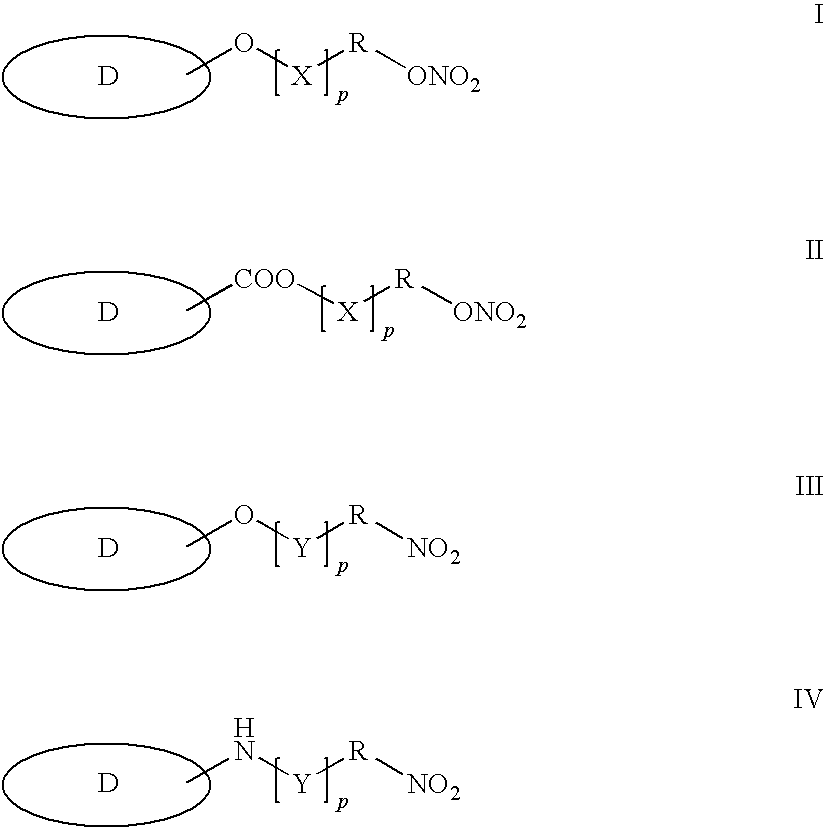Controlled Release of Nitric Oxide And Drugs From Functionalized Macromers And Oligomers
a technology of nitric oxide and oligomers, which is applied in the direction of catheters, extracellular fluid disorders, prostheses, etc., can solve the problems of recurrence of primary cardiac symptoms and effects, high experimental difficulty in regulating endogenous expression no using gene therapy techniques, and inability to achieve safe and effective effects
- Summary
- Abstract
- Description
- Claims
- Application Information
AI Technical Summary
Benefits of technology
Problems solved by technology
Method used
Image
Examples
example 1
Synthesis of 2-(6-methoxy-naphthalen-2-yl)-propionic acid benzyloxy-carbonyl methyl ester
[0170]
[0171]To a mixture of Naproxen (25 grams) and triethylamine (23 ml) in acetone (150 ml) was added benzyl chloroacetate (24 grams) drop wise, and the mixture was stirred at 50° C. temperature for three hours. The reaction mixture was poured onto cold water, and crude 2-(6-Methoxy-naphthalen-2-yl)-propionic acid benzyloxy-carbonyl methyl ester was filtered, dried and purified by recrystallizing from a mixture of ethyl acetate:hexane to give pure 2-(6-Methoxy-naphthalen-2-yl)-propionic acid benzyloxycarbonyl methyl ester (39 grams) as a white powder. m.p: 95.3-97.3° C. The pure product was characterized using 1H NMR spectroscopy in CDCl3: δ 1.60 (d, 3H, CH3), 3.80(m, 4H, CH and OCH3), 4.56(q, 2H, OCH2), 5.12(q, 2H, OCH2), 7.06(m, 2H, Ar), 7.30(m, 6H, Ar), 7.64(m, 3H, Ar)
example 2
Synthesis of 2-(6-methoxy-naphthalen-2-yl)-propionic acid carboxymethyl ester
[0172]
[0173]To a solution of 2-(6-methoxy-naphthalen-2-yl)-propionic acid benzyloxy carbonyl methyl ester (45 grams) in ethyl acetate (200 ml), was added 50% wet Palladium on carbon (10%, 9 grams), and the mixture was stirred under an atmosphere of hydrogen (4 Kg) overnight in a pressure vessel. The catalyst was removed by filtration and ethyl acetate was distilled under vacuum. The crude product was precipitated by adding hexane, filtered, dried, and purified by recrystallization in a mixture of ethyl acetate: hexane to get pure 2-(6-Methoxy-naphthalen-2-yl)-propionic acid carboxymethyl ester (30 grams) as a white powder with a melting point of 131-132.5° C. The pure product was characterized using 1H NMR spectroscopy in CDCl3: 1H NMR (CDCl3) δ 1.60(d, 3H, CH3), 3.88(s, 1H, OCH3), 3.94(m, 1H, CH), 4.54(q, 2H, OCH2), 7.06(m, 2H, Ar), 7.39(d, 1H, Ar), 7.64(m, 3H, Ar).
example 3
Synthesis of 2-(6-methoxy-naphthalen-2-yl)-propionic acid 4-bromo-butoxy carbonyl methyl ester
[0174]
[0175]To a mixture of 2-(6-Methoxy-naphthalen-2-yl)-propionic acid carboxymethyl ester (30 grams) and triethylamine (21.9 ml) in acetone (200 ml) was added 1,4-dibromobutane (90 grams) drop wise, and the mixture stirred at room temperature for 24 hours. The reaction mixture was poured onto cold water, and crude 2-(6-Methoxy-naphthalen-2-yl)-propionic acid 4-bromo-butoxy carbonyl methyl ester was extracted into dichloromethane. After drying over sodium sulphate, dichloromethane was distilled off under reduced pressure, and the residue was purified by column chromatography using hexane as an eluant to get 18 grams of 2-(6-Methoxy-naphthalen-2-yl)-propionic acid 4-bromo-butoxy carbonyl methyl ester as light brown syrup. The pure product was characterized using 1H NMR spectroscopy in CDCl3: δ 1.52(d, 3H, CH3), 1.62(m, 4H, CH2 X2), 3.16(t, 2H, CH2), 3.82(m, 4H, CH and OCH3), 3.98(t, 2H, C...
PUM
| Property | Measurement | Unit |
|---|---|---|
| thickness | aaaaa | aaaaa |
| thickness | aaaaa | aaaaa |
| temperature | aaaaa | aaaaa |
Abstract
Description
Claims
Application Information
 Login to View More
Login to View More - R&D
- Intellectual Property
- Life Sciences
- Materials
- Tech Scout
- Unparalleled Data Quality
- Higher Quality Content
- 60% Fewer Hallucinations
Browse by: Latest US Patents, China's latest patents, Technical Efficacy Thesaurus, Application Domain, Technology Topic, Popular Technical Reports.
© 2025 PatSnap. All rights reserved.Legal|Privacy policy|Modern Slavery Act Transparency Statement|Sitemap|About US| Contact US: help@patsnap.com



